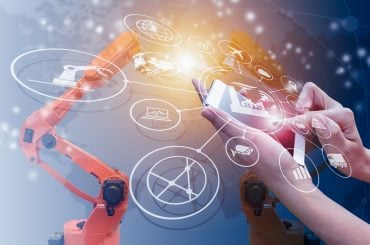
Digital onboarding can yield an increased volume and variety of customer data, near-real-time data-driven insights, and the ability to build personalized experiences that keep customers coming back again and again.
As a customer’s first meaningful encounter with your business, your onboarding process sets the pace and tone for the entire customer experience. It’s also your first opportunity to acquire valuable data that can drive actionable insights—if you approach it the right way.
Manual onboarding processes at brick-and-mortar locations force customers to make the time to come in, stand in line, and wait for the manual data intake—and if any documentation is missing or incomplete, they may have to leave and come back, starting the process all over again. From a data perspective, these processes carry a high risk of error and capture a limited amount of customer information. Service workers can misread handwriting, mix up documents, and overlook warning signs of fraud. Even if data is captured accurately, it likely will not flow smoothly (or quickly) into your analytics platforms, where it can fuel strategic decision making.
Fortunately, there’s a better way—for your customers and for your business.
A better way to onboard
A self-service digital onboarding platform—including secure identity proofing and affirmation—lets your customers open accounts any time, from anywhere, using only their smartphones. The information that is created along the way (demographics, location, device used, time of day, time to completion, etc.), combined with the extracted data from any digitized submitted documents, offers a treasure trove of customer data points with a high degree of accuracy.
With self-service onboarding, data is also delivered into your systems within minutes of being entered without requiring additional processing or incurring additional costs. Each new customer going through the process uses their own technology to create their own valuable data, avoiding the delays, cost, and risk of error inherent in manual processes.
In other words, … data quantity, check … data quality, check … data velocity, check.
See also: How Artificial Intelligence Can Improve Customer Experience
Proving identity securely
For years, many businesses have stuck with manual onboarding because of the difficulties of verifying customer identities via digital platforms. Fortunately, today’s proof-of-identity solutions not only enable customers to upload their identifying documents but also verify the validity of those documents as well as confirm that they correspond to the individual opening the account.
To be effective in affirming the customer’s identity and preventing fraud, a solution must cover both identity proofing and identity affirmation. Identity proofing involves three steps: collecting the customer’s data and identifying documents; determining the validity of the information and documents provided; and verifying the link between the data/documents and the identity of the customer. Identity affirmation requires using additional documents—like a birth certificate, utility bill, income statement, etc.—to affirm the submitted identity documentation. It might also leverage databases or external sources to verify the data.
So, for example, a customer can capture with their mobile phone a photo of their driver’s license as an identifying document, a utility bill to prove residency, and a selfie, and an effective proof-of-identity platform will
- Identify and extract the ID data for form prefill.
- Analyze the license to verify it is authentic.
- Identify and extract data from the utility bill and compare it to the ID.
- Compare the headshot photo from the ID to the real-time selfie to confirm the applicant is who they say they are.
See also: Service Intelligence Boosts Orgs, Improves Customer Experiences
Better data, better experience, happier customers
Digital onboarding delivers the quality and quantity of customer data that can drive optimized experiences that keep customers coming back. And because that data can flow directly into analytics platforms, it’s available almost immediately to enable data-driven strategic decisions on how to serve customers more effectively.
Better data, more efficient processes
The data that digital onboarding creates can also feed into process improvement platforms to drive operational efficiencies. When a new customer comes into your brick-and-mortar location, do you know how long they waited in line, what time of day it was, how long the actual process took, and/or how many additional visits it took to complete the process? You can’t improve the experience without this important data, which normally isn’t available without digital onboarding. On the other hand, shifting to a self-service digital onboarding solution allows for the use of process mining.
Process mining applications can examine log data from each step of the onboarding process and map out a primary path as well as any deviations that arise. These valuable insights help you better understand your onboarding process as it actually occurs (not just how it’s supposed to occur) and uncovers opportunities to eliminate inefficiencies and bottlenecks. The result is a streamlined process that makes more efficient use of your resources and delivers a better experience for your customers.
A digital onboarding solution also feeds data continuously into your process mining application. This allows you to automate the monitoring of your process so that, if inefficiencies arise in the future, you can identify them immediately and address them before they turn into major headaches.
Driving efficiencies across industries
Spurred by improved customer experiences and enhanced data capabilities, more organizations—in industries ranging from banking to healthcare to government—are embracing digital onboarding and proof-of-identity solutions. Those who have made the leap are uncovering significant advantages over competitors that lag behind. Using the enhanced data points that digital onboarding and proof-of-identity deliver, they can create more comprehensive and insightful customer profiles and fine-tune experiences throughout the customer journey to deliver superior, personalized service.
Part of a larger trend
The shift from in-person to online services is nothing new, as a drive past any abandoned shopping mall will affirm. However, when the Covid-19 pandemic led to widespread lockdowns, the velocity of this trend leaped into warp speed. Businesses that were forced to close or restrict access to brick-and-mortar locations had to find a way to serve their customers, and the web offered a solution.
As more transactions pivoted from in-person to online, the issue of verifying identity to prevent fraud became increasingly critical. Today’s proof-of-identity solutions address this need by applying intelligent document processing technologies to identifying documents and automating identity proofing and affirmation. Gartner predicts that by 2023, 85 percent of organizations will be using document-centric identity proofing as part of their onboarding processes.
The future of customer onboarding
As more customers demand self-serve solutions—and more businesses seek to enhance the quality, quantity, and velocity of their customer data—digital onboarding is continuing to gain acceptance across organizations of all sizes and in all industries. Those that seize this opportunity can look forward to the benefits of an increased volume and variety of customer data, near-real-time data-driven insights, and the ability to put this data to work in building personalized experiences that keep customers coming back again and again.




























